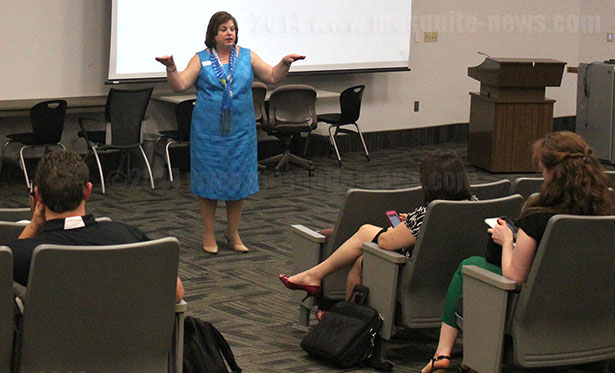
By Jacob Beltran and Emily Rodriguez
A proposed fixed-rate tuition and fee plan may lower stress over tuition increases, at least over the next three years.
Melissa Mahan, vice president for student affairs, presented the university’s proposal for a guaranteed tuition plan in a two-part student forum Monday and Wednesday.
The plan, drafted by university administration, responds to House Bill 29, signed by Gov. Rick Perry in June 2013. The bill requires every public university to offer undergraduate students the option of a four-year, fixed-rate tuition.
The original intent of the bill provides students and their parents the option of a fixed tuition price plan at Texas general academic teaching institutions, according to a committee report analysis authored by state Rep. Dan Branch, R-Dallas.
If the Board of Regents approves Texas A&M-San Antonio’s plan on May 1, returning and incoming A&M-San Antonio students will know exactly what their tuition will cost, which could make a big difference financially for students, Mahan suggested.
“That way students can budget from this point forward,” Mahan said. “They don’t have to be worried about their tuition going up.”
During her presentation Monday, Mahan said non-resident and graduate students are excluded from the guaranteed tuition plan, and are still subject to tuition increases.
Although many universities are planning four-year fixed-rate plans, A&M-San Antonio will offer a three-year plan because the university only provides junior and senior level courses.
Because the average student takes about 10 hours per semester, Mahan said the team calculated three years for undergraduates to finish their degree.
“That’s how we calculated how long it would take to have this guarantee,” she said.
Monday’s presentation included cost estimates totalled for the maximum allowed 15 credit per semester.
The estimates include a 2.2 percent tuition increase rate, Mahan said, adding that returning students are compounded over two years, but given the full three-year guarantee. She added that the projected tuition inflation prevents budgetary shortfalls.
New students, however, are compounded over three years — nine semesters — because they will most likely take the full three years to earn a degree.
For returning students, the fee is calculated with a 3.3 percent increase at $3,487.69 a semester for nine semesters, including Spring, Summer and Fall. Incoming students are charged a 4.5 percent increase at $3,526.19.
The mentioned figures include a consolidated mandatory fee, excluding a student-approved recreation fee. If approved, the fee will apply separately from the university services fee.
The Board of Regents will vote on the fee and tuition plan at their May 1 quarterly meeting.
Mahan said if a student misses a semester, they can extend the fixed rate if a university appeals committee approves the student’s extenuating circumstances.
The committee does not yet exist but Mahan said they plan on having a short appeal process to get students back in school.
The guaranteed tuition does not affect financial aid, Mahan said, and students are still subject to the same rules and regulations enforced by Federal Student Aid.
Mahan said the plan will change to accommodate freshman and sophomore students once the university becomes a four-year institution.
“That’s going to change in the future, but we don’t know when or how soon that will be,” she said.
Monday’s forum included a Q&A opportunity for the student body, but members of the administration and Student Government Association outnumbered undergraduate students.
At Wednesday’s forum, only members of the SGA attended the brief 10-minute presentation.
Unlike the recreation fee forum, SGA did not have an active role. Members attended both tuition forums to show their support but did not advertise it other than creating Facebook posts encouraging attendance.
“We should have had a more active role if we want more students to be here. We are the student government and we do represent our students,” Jenna Bonilla-Mata, senator for the College of Arts and Sciences, said in an interview after the forum. “I think this should have been communicated to us earlier in the semester so we could have promoted it instead of being told a few days before.”
Mahan said the forum was advertised via the university’s Facebook, Twitter, email and flyers.
Although a fixed-rate tuition appealed to students at the forum, some questioned if they will benefit from it.
“I like the idea of a guaranteed rate, but am I going to benefit from this?” Allison Garcia, senator for the college of education and kinesiology, said. Garcia plans on attending graduate school at this university.
SGA Historian Sylvia Soto, a bilingual education graduate student, expressed concern about tuition increases for graduate students not covered by the plan, to make up for revenue loss.
“As a graduate student, I don’t feel comfortable with it,” Soto said in an interview after the Wednesday forum. “If the school needs more money than the 2.2 percent covers, they may come to us to make up the difference. It’s only fair for students to have the same opportunity.”
The university enrolled 1,105 graduate students this semester, and offers 10 graduate programs.
Garcia said she has spoken to kinesiology students and found they are not aware of the tuition plan and expressed discomfort with the inflation rate.
“I would like an opt-in, opt-out option. I really want to look at my tuition from ‘13 to ‘12 and look at the percentage difference,” she said. “What if there was only a one percent inflation instead of 2.2? Then I’m really not getting a deal out of this.”
After the forum, Mahan said the Alamo Community College District was not consulted in the creation of the tuition plan.
If the plan is approved by the Board of Regents, Mahan said she will make an effort to communicate with Alamo Colleges.
Students who are dual enrolled at any of the Alamo Colleges and this university are subject to the tuition plan.






